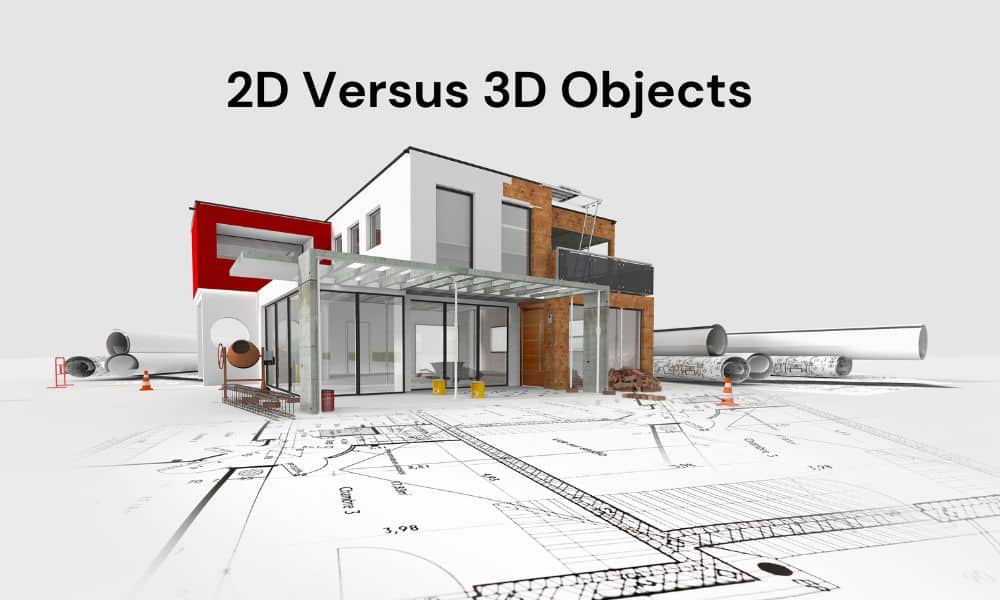
In mathematics, art, and everyday life, we encounter objects that exist in two dimensions (2D) and three dimensions (3D). Understanding the differences between these two types of objects is crucial for grasping concepts in geometry, physics, and various design and engineering fields.
This article delves into the definitions, properties, examples, and applications of 2D and 3D objects, clearly comparing and highlighting their significance in our world.
What are 2D objects?
Definition:
2D objects are shapes that exist on a flat plane. They have two dimensions: length and width. These objects do not have depth, meaning they have no thickness and cannot exist in the physical world in their purest form.
Properties:
- Dimensions: Length and width.
- Area: 2D objects have an area, which is the amount of space they cover on a plane.
- Perimeter: The total length around the edges of a 2D object.
- Examples: Squares, rectangles, circles, triangles, and polygons.
Applications:
- Art and design: 2D shapes are fundamental in creating drawings, paintings, and graphic designs.
- Geometry: Studying properties of shapes, calculating areas and perimeters, and understanding congruence and similarity.
- Technology: Icons, logos, and user interface elements are often designed as 2D objects.
What are 3D objects?
Definition:
3D objects have three dimensions: length, width, and depth. These objects have volume and can exist in the physical world. They occupy space and can be measured in terms of mass and volume.
Properties:
- Dimensions: Length, width, and depth.
- Volume: The amount of space a 3D object occupies.
- Surface Area: The total area of all the surfaces of a 3D object.
- Examples: Cubes, spheres, cylinders, cones, and pyramids.
Applications:
- Engineering and architecture: Designing and constructing buildings, bridges, and various structures.
- Physics and chemistry: Understanding the shapes and volumes of molecules, forces, and physical phenomena.
- 3D Modeling and printing: Creating models for animation, gaming, and prototyping products.
Comparing 2D and 3D objects
Dimensions:
- 2D: Length and width.
- 3D: Length, width, and depth.
Measurement:
- 2D: Area and perimeter.
- 3D: Volume and surface area.
Existence:
- 2D: Exists conceptually and visually on flat surfaces.
- 3D: Exists physically and can be manipulated in real space.
Examples in real life:
- 2D: Drawings, paintings, floor plans, and screens.
- 3D: Buildings, sculptures, furniture, and living organisms.
Visual representation:
- 2D objects can be represented in art as silhouettes or outlines.
- 3D objects are often represented in 2D spaces through techniques like perspective drawing and shading to give an illusion of depth.
Educational importance:
Understanding 2D shapes is foundational in early mathematics education, leading to a comprehension of more complex 3D shapes and spatial reasoning skills. Knowledge of both is essential for fields such as geometry, trigonometry, and calculus.
Conclusion
The distinction between 2D and 3D objects is fundamental in various disciplines, from mathematics and art to engineering and physics. 2D objects provide the basis for understanding shapes and areas on a plane, while 3D objects extend these concepts into real-world applications involving volume and surface area. By recognizing and exploring the properties and applications of both types of objects, we gain a deeper appreciation of the spatial structures that shape our world.
Edublox offers cognitive training and live online tutoring to students with dyslexia, dysgraphia, dyscalculia, and other learning disabilities. Our students are in the United States, Canada, Australia, and elsewhere. Book a free consultation to discuss your child’s learning needs.
Authored by Shanice Jordaan. Shanice holds a bachelor’s degree in education and has extensive teaching experience, having taught math for five years and English for three. She leverages her skills as an English teacher, online ESL teacher, and math and reading tutor to design engaging lessons, foster positive learning environments, and cater to diverse learning needs.
